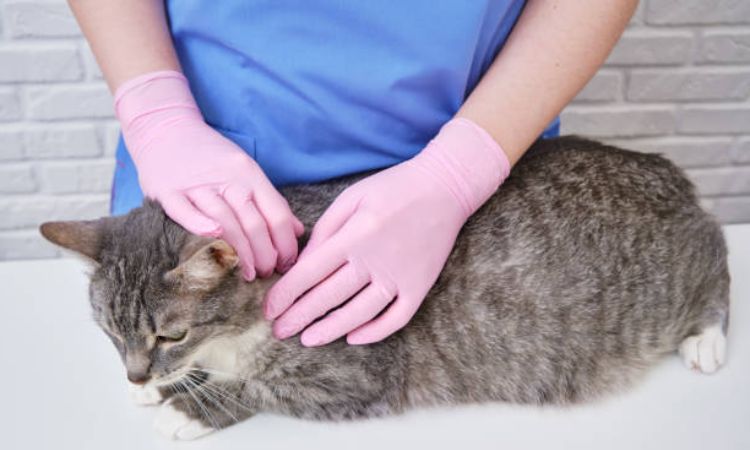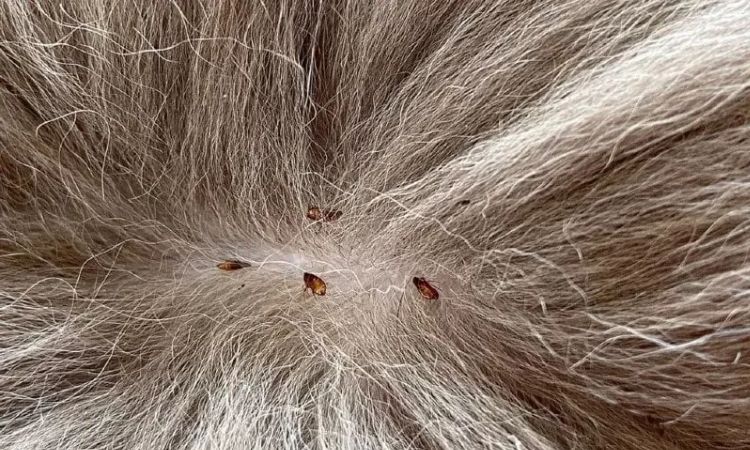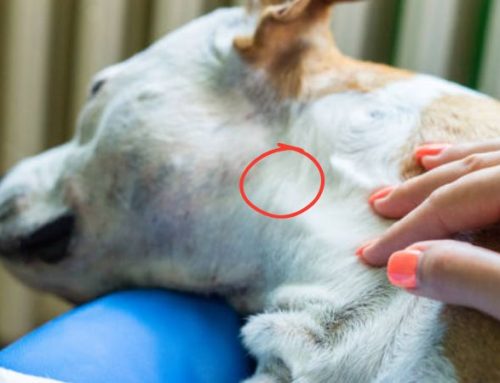If your feline friend has been scratching a little more than usual or seems restless, it might be more than just a passing itch. Cat lice, fleas, and ticks are sneaky little intruders that can turn your cozy home into a tiny battlefield for your pet’s comfort and health.
In this guide, Nexus-Pets will walk you through how to spot these pesky parasites, tackle them effectively, and keep your cat protected so you both can enjoy worry-free snuggles.
How to Deal with Cat Lice

What Are Cat Lice?
Cat lice (Felicola subrostratus) are tiny, six-legged, wingless insects that survive by chewing on the skin and hair of their feline hosts. Unlike fleas or ticks, lice are host-specific, meaning they only infest cats and cannot be transmitted to humans or dogs. Female lice lay eggs, called nits, which attach firmly to hair shafts and take about 3–4 weeks to hatch. Lice infestations are now rare thanks to widespread flea and tick prevention, but cats in poor hygiene conditions, feral or stray cats, or older cats that cannot groom themselves are most at risk.
Signs of Cat Lice on Your Cat
- Visual Inspection: Look closely at your cat’s fur, particularly around the ears, neck, shoulders, and groin. Adult lice are tiny and move slowly through the hair, while nits appear as small white dots firmly attached to the hair shafts. Parting the fur can help you see these clearly.
- Physical Symptoms: Cats infested with lice often show excessive scratching, biting, or rubbing. Hair loss, scabs, matted fur, and restlessness may also be present. Lice infestations can lead to secondary skin infections if left untreated.
Effective Cat Lice Treatments
- Vet-Approved Products: The safest and most effective treatment is a prescription topical solution, which kills adult lice. Commonly used products include selamectin, fipronil, and lime sulfur dips (for kittens old enough to tolerate them). Treatments usually need to be repeated every 1–2 weeks to eliminate newly hatched nymphs. Avoid using dog-specific products on cats, as they may be toxic.
- Environmental Cleaning: To prevent re-infestation, wash all bedding, toys, and blankets in hot, soapy water. Grooming tools, collars, and carriers should be disinfected or sealed in plastic bags for a few weeks. Lice cannot survive off the host for more than a week, but thorough cleaning is essential to stop indirect transmission.
- A Word of Caution: Always consult your veterinarian before applying any external parasite treatments. Cats are sensitive to many insecticides, and using the wrong product can be harmful or even fatal.
By recognizing the signs early and using proper veterinary treatments along with environmental cleaning, you can quickly eliminate lice infestations and keep your cat comfortable and healthy.
Tackling Fleas and Their Lifecycle
Fleas are tiny, wingless insects that survive by feeding on the blood of cats. The most common culprit is the cat flea (Ctenocephalides felis), which reproduces rapidly and can quickly turn a single flea sighting into a full-blown infestation. After feeding, adult female fleas lay eggs that fall off the cat and settle into the surrounding environment—carpets, bedding, and furniture—where they hatch into larvae and eventually mature into adult fleas. This life cycle, from egg to adult, can take as little as two to three weeks under favorable conditions, making prompt action essential.
Cats with fleas may show signs such as constant scratching, hair loss, skin redness, or restlessness. You may also notice tiny black specks, known as flea dirt, which are flea droppings left in the fur.
Effective flea control involves a combination of approaches: vet-approved spot-on treatments, oral medications, regular grooming with a fine-toothed flea comb, and thorough cleaning of the cat’s environment. Understanding the flea life cycle and detecting infestations early are key steps to keeping your feline comfortable and your home pest-free.

Identifying and Removing Ticks
Ticks are slow-moving parasites that feed on your cat’s blood and can carry harmful diseases. Knowing how to spot, safely remove, and prevent ticks is crucial for keeping your feline healthy.
Spotting Ticks on Your Cat
Where to Check: Ticks often attach to warm, thinly furred areas. Key places to inspect include:
- Ears and ear folds
- Neck and under the collar area
- Between toes and paw pads
- Around the head and face
What a Tick Looks Like: Ticks are small, oval-shaped insects, typically brown or gray. They may appear flattened or engorged depending on whether they’ve fed. Unlike harmless skin bumps, ticks are firmly attached to the skin and may be surrounded by tiny black specks—droppings or debris from the tick.

The Right Way to Remove a Tick
Essential Tools: To safely remove a tick, gather:
- Tweezers or a dedicated tick removal tool
- Disposable gloves
- A small container or sealed bag to store the tick after removal
- Cat-safe disinfectant
- Optional: a helper to gently hold your cat
Step-by-Step Removal:
- Ensure your cat is calm; enlist a helper if necessary.
- Part the fur and position the tweezers as close to the skin as possible.
- Pull upward with steady pressure—avoid twisting or jerking to prevent the tick’s head from remaining embedded.
- Place the tick in a container for disposal or flush it down the toilet.
- Clean the bite site with disinfectant and wash your hands thoroughly.
Tick Prevention for Cats
Monthly Preventatives: Spot-on or oral tick preventatives prescribed by your veterinarian offer ongoing protection. These treatments not only prevent tick attachment but often protect against fleas and other external parasites as well.
Yard Management: Reducing tick habitats outdoors can lower the risk of infestation:
- Keep grass short and trim overgrown bushes.
- Remove leaf litter and debris where ticks hide.
- Create tick-safe zones for outdoor cats, avoiding areas where ticks are common.
By routinely checking your cat, knowing how to remove ticks safely, and using preventative measures, you can protect your feline companion from discomfort and disease.
A Proactive Approach to Parasite Prevention

Choosing the Right Preventative Product
Topicals vs. Oral Medications
Topical Treatments: Applied to the back of your cat’s neck, these solutions are absorbed through the skin and protect against fleas, ticks, and sometimes worms. They typically last about a month and are effective for cats who tolerate topical applications well.
Oral Medications: Administered as pills or chewables, these treatments kill parasites when they bite or infect your cat. Oral medications may also prevent heartworms, intestinal worms, and other external parasites. They are often preferred for cats sensitive to chemicals in topical products.
Pros and Cons: Topicals are easy to apply but may leave residue on fur, and some cats may react to certain chemicals. Oral medications avoid topical reactions but require your cat to ingest the treatment and may not cover all parasite types.
All-in-One Solutions
Modern preventative products often provide broad-spectrum protection, addressing multiple parasites in a single treatment. These “all-in-one” options can include coverage for:
- Fleas and ticks
- Mites and lice
- Heartworm
- Intestinal worms (tapeworms, roundworms, hookworms)
Using an all-in-one product simplifies parasite prevention, reduces the risk of missed treatments, and ensures comprehensive protection. Always consult your veterinarian to choose a product that fits your cat’s lifestyle and risk factors.
When to Contact Your Veterinarian
Persistent Infestations
If your cat continues to show signs of parasites despite at-home prevention, it’s essential to consult a veterinarian. Persistent infestations may indicate:
- Incorrect product application
- Resistance to certain medications
- Hidden environmental sources of parasites
Secondary Infections
Scratching, biting, or grooming in response to parasites can lead to skin injuries, inflammation, or bacterial infections. A vet can evaluate and treat these secondary conditions to prevent long-term damage.
General Health Concerns
Before starting any new parasite prevention routine, a professional evaluation is crucial. Your veterinarian can:
- Recommend the safest and most effective products for your cat
- Tailor treatment schedules based on age, health, and outdoor activity
- Identify other underlying health concerns that may make your cat more susceptible to parasites
Taking a proactive, informed approach ensures your cat remains healthy, comfortable, and free from parasites year-round. Regular veterinary guidance, combined with appropriate preventative products, is the best strategy for long-term protection.






